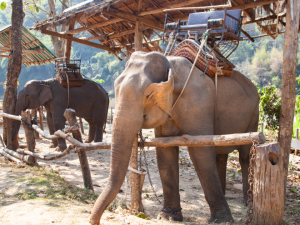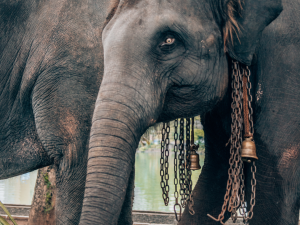Never Ride an Elephant

In the last 75 years, the population of the Asian elephant has halved, leading to its current status as endangered.

There are less than 50,000 left in the wild due to this decline, primarily from poaching and loss of habitat, and they now live in only 15% of their original range across Asia. These magnificent animals are forest gardeners, essential for shaping the vegetation and digging new water holes for themselves and other creatures.
The unique appeal of such gentle giants has led to elephant tourism around the world. It’s an enormously popular and profitable part of the tourism industry, especially in parts of Southeast Asia such as India, Thailand, and Sri Lanka. Unfortunately, it is often extremely damaging to the wellbeing of the very animals tourists love to experience up close.
The Elephant Cruelty You Don’t See
Even if an elephant in the tourism industry looks healthy, they are likely to have suffered years or even decades of mistreatment and cruelty. Around 15,000 Asian elephants are in captivity, and most of these were taken from the wild when they were very young. Once imprisoned, they are physically abused, tortured, and starved to make them tame so they can be ridden, perform, work, or beg. This process is known as “the crush” because it crushes the elephant’s spirit.
Terrible treatment continues throughout the life of captive elephants – the sharp bullhook is used to discipline and train them, they are often underfed, and they are usually tightly chained which causes sores and abscesses. Carrying the heavy howdah, the large metal and wooden seat that can accommodate several people, damages the elephant’s spine and is often chained so tightly it crushes their ribcage.
Ethical Elephant Tourism

Luckily, not all elephant tourism is bad. There are places with ethical elephant tourism, where the elephants are well-treated, respected, and not trained or ridden. If you want to meet an elephant, the most important thing to remember is to do your research and make sure the place you visit is a genuine elephant sanctuary, not somewhere that simply “greenwashes” their marketing to make it sound ethical whilst still making the elephants complete unnatural tasks.
Going on a walk with an elephant at a reputable sanctuary is by far the best way of interacting with them as it is part of their natural behaviour – they can walk up to 200km in one day! It will give you an up close and personal experience whilst supporting the welfare of these beautiful animals.
The Wildlife SOS Elephant Conservation and Care Centre in Mathura, India, and Elephant Nature Park in Chiang Mai, Thailand, are two charitable organisations that have the wellbeing of Asian elephants at their hearts. They both offer opportunities to observe, meet, and care for these majestic animals while they interact and play in natural surroundings.
If you would like to support the wellbeing and care of Asian elephants, please visit or donate to charities such as Wildlife SOS, Save the Elephants, International Elephant Foundation, and Sheldrick Wildlife Trust.


🤗
Thank you!